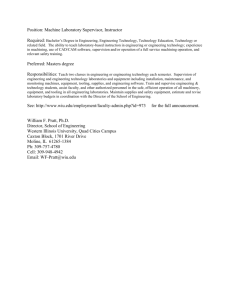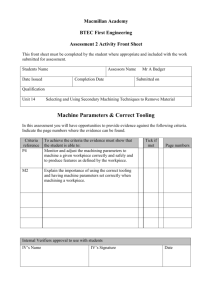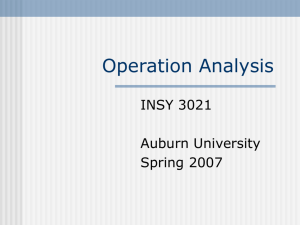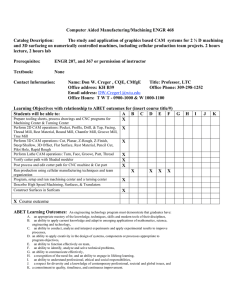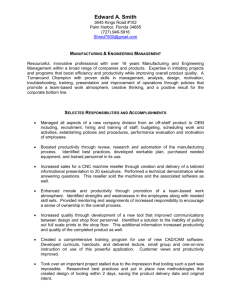Sinclair Community College
advertisement
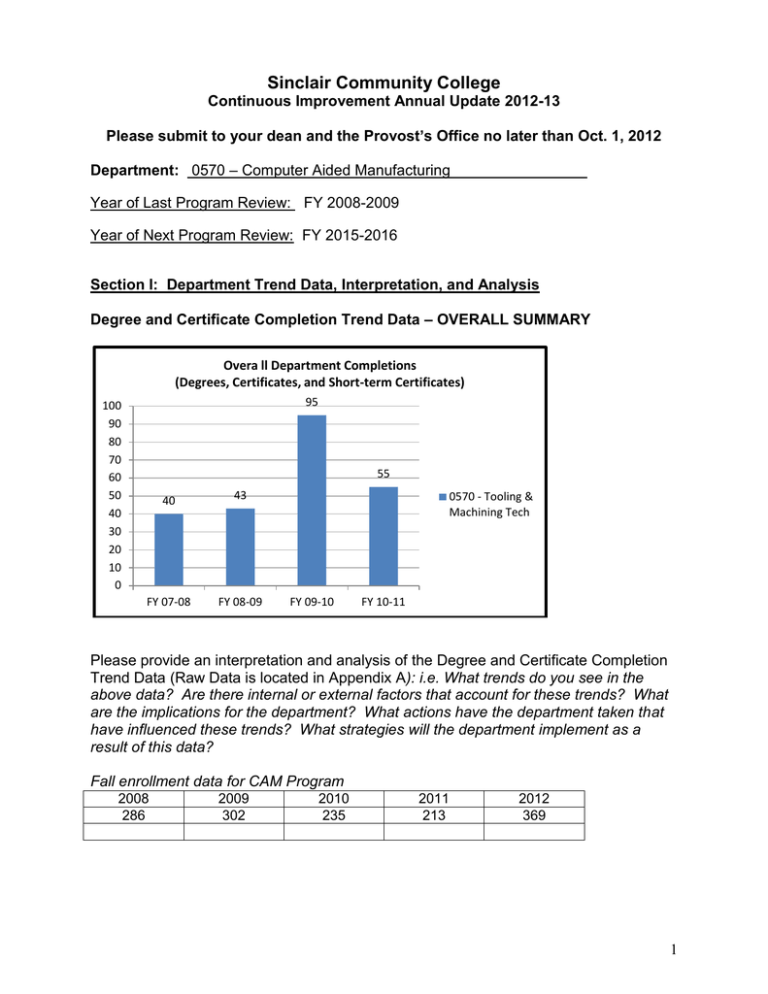
Sinclair Community College Continuous Improvement Annual Update 2012-13 Please submit to your dean and the Provost’s Office no later than Oct. 1, 2012 Department: 0570 – Computer Aided Manufacturing Year of Last Program Review: FY 2008-2009 Year of Next Program Review: FY 2015-2016 Section I: Department Trend Data, Interpretation, and Analysis Degree and Certificate Completion Trend Data – OVERALL SUMMARY Overa ll Department Completions (Degrees, Certificates, and Short-term Certificates) 95 100 90 80 70 60 50 40 30 20 10 0 55 40 43 FY 07-08 FY 08-09 0570 - Tooling & Machining Tech FY 09-10 FY 10-11 Please provide an interpretation and analysis of the Degree and Certificate Completion Trend Data (Raw Data is located in Appendix A): i.e. What trends do you see in the above data? Are there internal or external factors that account for these trends? What are the implications for the department? What actions have the department taken that have influenced these trends? What strategies will the department implement as a result of this data? Fall enrollment data for CAM Program 2008 286 2009 302 2010 235 2011 213 2012 369 1 The graduation numbers for both degrees and certificates have been: Degrees Certificates STEP II* Short term Total degrees/Certificates 08-09 10 40 29 7 57 09-10 23 43 37 25 91 10-11 15 12 10 28 55 11-12 16 15 14 16 47 STEP II included in certificates, broken out to show impact Trends Looking at the trend data in the above graph (which is missing FY 2011-2012 which is 47) you can see that we have dropped from a high of 95 in 09-10 to mid 50's currently. The current enrollment for 2012 (see above chart) is the highest we have seen since 09-10 and if we are able to maintain our completion rate we should see graduation numbers comparable to 09-10 if not higher. Enrollment for fall 2009 was 302, while 2012 is 369. As the general economy improves, we are starting to see more students enroll in the program. We have surveyed every student this fall and discovered that 90%+ entered the program through word of mouth referrals from friends and family and from the general good news in the media about the availability of jobs in this area. We (faculty and staff of CAM department) have also visited most High school career days, local companies and DEV 84 classes to enroll students. We do no prescreening to eliminate potential candidates, but let the course work screen out those who cannot meet the requirements (see completion data in next section). We have had many discussions as a department that argue if we screened candidates we would have a higher success rate, but the negative side of that argument, is the potential for excluding students who would succeed. We do, however, test potential coop students with the NTMA skills test which assesses basic mechanical aptitude, math and general reasoning skills. Only those students who pass the test are allowed to participate in coop. We are currently planning on keeping the coop program as we migrate to semesters. Our goal as a department is to create so much interest and demand for the program, that we will be forced to go to a waiting list or start screening. For Fall of 2012, 85% of sections offered are full. We still have some room to offer additional sections, but unless we expand off the main campus, our lab space becomes the limiting factor, unless we offer weekend classes, or more evening classes. The implication is now finding enough qualified instructors to handle those classes. We are also working with Preble County and Warren County to try to address demand for those areas. Currently, we do not have physical facilities to allow us to run any machining classes in those areas, but we are working on that issue with Workforce Development through a grant for Preble county and local industries. All the data we look at and gather from our industry sources tells us that this is a long term trend, not just a blip. The rationale behind such forecasts takes into account current shortages of skilled machinists, unemployment rate, potential wages, and the impending retirement of numerous "Baby Boomers" which will only exacerbate the current shortages. Our strategy is to work the channels we are currently working: • Working on increasing the Advertising of the program (including degrees and certificates) with Sinclair’s Marketing and Admissions Department. Currently Sinclair does not market individual programs, but we are looking at ways to get the word about 2 our Machining program to the general public. This includes newspaper articles, development of a new Brochure and possibly creating a marketing video that could be placed on Youtube or other social media. • Working with Sharma Fox in Academic Services to develop an in-house screening test, which would identify strong candidates for the machining program. • Looking at modifying the CAM Degrees and Certificates so they could be completed in less time. • Conducting more machining classes at local high schools or making better connections through Tech Prep to encourage those high School graduates to continue their education at Sinclair. We are currently offering classes at Ponitz Career Academy, Mound Street Academy and looking to start at Belmont HS. We are working with Miami Valley CTC and Stebbins High Schools to give their tech prep students articulation credits or allow them to “test out” of certain courses based on what they have taken in high school • We are continuing to host the Regional SKILLS USA machining contest and for the third straight year host the SKILLS USA statewide contest for manual machining. This will also be our the second year hosting the CNC Lathe/Mill programming contest. This gives great exposure to our program statewide. • We have worked with Academic advising so that our STEP II coordinator will do most of the advising and scheduling for our STEP II students. This is in addition to hosting several “information sessions” about STEP II and taking prospective students and parents on tours of our facilities (basically a one on one recruiting session). • Working closely with the DRMA (Dayton Region Manufacturers Association (Formerly the DTMA) to recruit current workers to enhance their skills. This is where there are some problems since most employers now have their employees working more than 40 hours per week which leaves them no time for school. Dayton Progress is one example of a company who still encourages continuing education and roughly 25% of their employees take classes at Sinclair related to the machining field. • The success rates of these courses lead to more detailed analysis of the content. INT 107 and 109 are introductory courses that are taken by students other than INT. INT 107 is basic print reading and drawing interpretation. Without this skill a person has no chance of becoming a machinist. We are evaluating some of the activities to help make the material clearer to the students without sacrificing proficiency. We are investigating using the prints for the INT109 (now CAM 1109) projects as part of the CAM 1107 class. We will evaluate how this impacts student success. • The INT 161,162,163 series is key for the STEP II program. Typically we measure the number of students who start in INT 161 with the number who successfully complete INT 163. This is indicative of how the students succeed in STEP II. Currently we are around 50%. We would like to see that number be higher, but we feel it reflects non-pre-testing of our students. •INT 213 is the capstone course for the CNC degree. That runs close to 100% and we feel it is indicative of the students in the program. Typically, STEP II is for people entering the trade, while CNC is for people who have had some experience. We feel that is indicated in the success rates. 3 Course Success Trend Data – OVERALL SUMMARY Overall Department Success Rates 100.0% 90.0% 78.2% 81.5% 75.2% 74.3% 80.0% 69.8% 70.0% 60.0% 50.0% 40.0% 30.0% 20.0% 10.0% 0.0% FY 07-08 FY 08-09 FY 09-10 FY 10-11 FY 11-12 (excludes Spring) 0570 - Tooling & Machining Tech SME COLLEGEWIDE Please provide an interpretation and analysis of the Course Success Trend Data (Raw Data is located in Appendix A). Looking at the success rate data provided in the Appendix for each course, please discuss trends for high enrollment courses, courses used extensively by other departments, and courses where there have been substantial changes in success. Looking at the data above, we can see that roughly 3/4 of our students are successful in the classes they take in our Program. From the data in Appendix A, it can be seen that INT 107 (now CAM 1107) has the lowest success rate. This is a print reading/CAD class and our analysis and data showed many students taking the necessary computer skills to succeed. To address this, we added MET 1131 as a prerequisite for this course. We are monitoring to see if this will make a difference. Also, as mentioned above, we are trying using prints for CAM 1109 and CAM 1161 in CAM 1107 to help insure students are able to read and understand what they are to build. The success rates for the other courses have remained relatively constant the past 4 years. Our most important series are INT 141,142,and143 (Now CAM 1141 and CAM 1142) which are shop math courses and INT 161,162,163 (Now CAM 1161 and 1162) which are machine shop courses set to simulate working in a company. The success for each class increases as students move on, which is to be expected since those unable to perform weed themselves out. In machining, as in Allied Health, close is not good enough. Work must be exact and we hold our students to exacting standards. The biggest challenge we face is pressure from our industry partners to “speed up” the process and get students out sooner. The argument becomes speed versus quality. We are listening to the voice of the customer and striving to satisfy their demands while not lowering the integrity of our Program. This is taking the form of revising our curriculum and trying to lattice certificates and degrees into smaller units, so a student can gain enough knowledge to get a job, but continue on the path of continuing education to upgrade skills. Overall, even with these tight expectations, we are still above the division and Collegewide averages for success. 4 The switch to semesters has hurt some enrollment in the program in that Automotive students no longer can use our shop math (CAM 1141) to fulfill their math requirements. The CAM 1109 class includes students outside the CAM Program and generally the results have been very good. Success rates in that class (formerly INT 109) has been approaching 80% up approximately 10%. This is due to focusing on the needs of the students taking the course and modifying assignments since many students are not pursuing this as a career choice but rather an appreciation/understanding the basic principles course. Please provide any additional data and analysis that illustrates what is going on in the department (examples might include accreditation data, program data, benchmark data from national exams, course sequence completion, retention, demographic data, data on placement of graduates, graduate survey data, etc.) Currently, the demand for graduates of this program (certificate and degree) is not keeping pace with demand. Therefore, generally all students who want a job have been successful in obtaining one. The biggest drawback is with a blemish on their criminal record, which makes job placement harder. We are currently working with two State sponsored Organizations: Impact and The Ridge Project, whose main focus is those in low economic circumstances or those who have served time for criminal activities. We are actively working with prospective employers to see if they will be willing to hire people with this type history. 5 Section II: Progress Since the Most Recent Review Below are the goals from Section IV part E of your last Program Review Self-Study. Describe progress or changes made toward meeting each goal over the last year. GOALS Distance Learning: The CAM department is exploring distance learning opportunities for some of its manufacturing courses. It may be possible to incorporate some of the web material from Haas Automation. Course enhancements, and hybrids are being considered as well as full web courses. 4 and 5 Axis Machining: The new Haas CNC machines give us the added capability of 4 and 5 axis programming and machining. The CAM department is beginning to explore how this technology can be incorporated into the curriculum. Tabletop Simulators: Our new Haas tabletop control simulators may allow us to offer CNC programming courses in different locations. Status In progress Completed No longer applicable In progress Completed No longer applicable In progress Progress or Rationale for No Longer Applicable With the move to semesters, the course we used to offer as a web based class (INT 141) has been modified to include additional material, including a lab component which makes distance learning an “iffy” proposition right now, but we are still looking at whether we can make this happen, perhaps as a hybrid course. The “Virtual Haas” grant proved to be unsatisfactory at this time due to software reliability. It did not meet our expectations. However, there have been revisions to the software and website, so we are considering trying to use it again. This course is now being offered in Spring and is CAM 2214 – Advanced Computer Numerical Control (CNC) applications will cover the 4 and 5 axis applications. This has also been coupled with the switch from EdgeCAM to MasterCAM for our Computer Aided design course (CAM 2212) which is need for the 4 and 5 axis applications. Table top simulators have not proven to be as portable as we would have liked, but we have had Ponitz acquire some of these so this course could be offered there. Completed No longer applicable Bio-Manufacturing: We will explore opportunities in the emerging fields of bio-manufacturing and medical devices. In progress The bio-medical field makes use of 4 and 5 axis machining centers, so with the advent of the new course, more possibilities open up for our students. Completed 6 No longer applicable 7 Below are the Recommendations for Action made by the review team. Describe the progress or changes made toward meeting each recommendation over the last year. RECOMMENDATIONS The department could consider developing additional methods of recruiting students, including use of the web-site and possibly forming partnerships with career technical programs. There is a need to build adjunct faculty ranks to manage projected enrollment growth, and the department should develop strategies that will facilitate this process. If there is a threat posed by emerging competition from forprofit organizations and career technology centers, the department should seek ways to publicly differentiate the Sinclair program and what it has to offer from others. Status In progress Completed Progress or Rationale for No Longer Applicable We are trying every means possible to recruit students, including using our industry partners through DRMA and our Advisory committee. We are working with Tech prep to replace test out agreements with articulation credits if students pass particular courses with at least a “C”. No longer applicable In progress Completed No longer applicable We have hired a former employee, and are in the process of hiring a graduate of our program as Adjuncts. We are also making use of one of our Adjuncts in OPT, Phil Garland, who is also our part-time technician, to teach some courses in CAM.As we face some retirements and loss of current adjuncts we will be taking steps to ensure that our courses can be covered. o In progress Completed No longer applicable o The two major ways we differentiated ourselves from the competition was by our involvement with HAAS as a certified HAAS Tech Center (one of only 2 in the State of Ohio) and we created a short term CNC Certificate to upgrade skills of current workers. Unfortunately, HAAS has ended their support of the HAAS Tech centers, but we did purchase the three HAAAS Vertical Mills to continue with the Program. This has resulted in a new course for semesters (CAM 2214) and the acquisition of MasterCAM software allowed us to more fully utilize the capabilities of our machines. We have instituted a Co-op program for STEP II participants. They volunteer and take a test to qualify for the Co-op program, and we find employers willing to hire them for 11weeks. They need to do the interviewing and get the positions. This extends the STEPII certificate for 1 extra 8 The faculty is encouraged to consider alternative delivery strategies, e.g. non-credit courses and short-term certificates, to meet the community’s need for workforce development and to plan future approaches to meeting needs related to new applications in areas such as bio-manufacturing and manufacturing of medical devices. While it is clear that excellent learning experiences designed to facilitate the achievement of general education outcomes as well as program outcomes are in place, there is no documented evidence that those outcomes are being met. If needed, support is available through the College-Wide Assessment Committee to design methods for collecting, analyzing, and documenting data regarding these outcomes. In progress Completed No longer applicable In progress Completed No longer applicable quarter (Summer), but the results have been very positive. We are working to carry this over into semesters on a 16 week basis. We are currently exploring this with our Advisory Committee members o We are offering a short term CNC Certificate as mentioned above, and are trying to find ways to shorten it since it expanded to 3 semesters. The faculty have come up with proposals we are evaluating. Goal is to have them available for fall 2013. o We have been working with Workforce development to provide non-credit training to local companies. o We have had faculty trained in 4 and 5 axis programming on HAAS Vertical Machining Centers to expand our capabilities in the Biomedical field. We are planning to make use of the Assessment Committee to help us with the general education outcomes. These provide to our students what potential suppliers call “soft skills”. We try to incorporate some of these activities in courses in our curriculum from outside CAM, but we understand we are lacking in hard data. Once we get that, the analysis and documentation will become meaningful and help guide our Program. 9 Section III: Assessment of General Education & Degree Program Outcomes The Program Outcomes for the degrees are listed below. All program outcomes must be assessed at least once during the 5 year Program Review cycle, and assessment of program outcomes must occur each year. General Education Outcomes To which degree(s) is this program outcome related? Year assessed or to be assessed. Assessment Methods Used What were the assessment results? (Please provide brief summary data) All programs 2011-2012 Currently, only our Associate Degree programs have students taking courses in Communication. However, many of our classes require verbal communication between students and between students and professors and staff. We are using exams, portfolios, and rubrics to gather data. The main courses that use these skills are CAM 1107, 1109, 1161,1162 and 2780 the capstone course. The results generally follow closely the success rates in those classes, since the methods mentioned tend to generate most of the grade. In addition, students taking course in OPT have to complete a team project with a written (PowerPoint) presentation which they Present to the class (verbal communication). Results from the courses that were replaced by the switch to semesters (OPT 101, 130, 206, 240). Here we identify which students are in the CAM program and we keep track of how they perform. We have seen that 80% of the students scored 80% or greater on exams and presentation rubrics. All programs 2011-2012 Please see above since both forms of communication are related. Please see above. In the Cam 1107 (formerly INT107) we consider drawing a form of written communication. The results generally follow the success rates in these course. Oral Communication Written Communication 10 Critical Thinking/Problem Solving Values/Citizenship/Community Computer Literacy Information Literacy Program Outcomes All programs All programs All programs All programs 2012-2013 2013-2014 2014-2015 2015-2016 To which course(s) is this program outcome related? Year assessed or to be assessed. Demonstrate technical engineering skills appropriate to program requirements. CAM 1109,1213,21 45,2204,2212, 2214,2780 Analyze manufacturing engineering problems (general and technical) and make appropriate decisions. CAM 1107, 2145,2204,22 12,2213,2214, OPT 1100, MET 1131, OPT 2240 Demonstrate mathematical skills required for occupation. MAT 1270, CAM 1141,1142, OTM Physical Sci, Identify new changes in career field and build personal skills to maintain state-of-the-art competencies. CAM 2212,2213,22 14, COM 2206, OTM Assessment Methods Used What were the assessment results? (Please provide brief summary data) 2012-2013 Simulations Performance appraisals Since these are new courses due to the switch to semesters, it is too early to tell how we are doing. The major point now is to develop meaningful measurements, analyze and make changes based upon data 2012-2013 Simulations Performance appraisals Exams Since these are new courses due to the switch to semesters, it is too early to tell how we are doing. The major point now is to develop meaningful measurements, analyze and make changes based upon data 2014-15 Exams Since these are new courses due to the switch to semesters, it is too early to tell how we are doing. The major point now is to develop meaningful measurements, analyze and make changes based upon data 2015-16 Exams Performance Appraisals Since these are new courses due to the switch to semesters, it is too early to tell how we are doing. The major point now is to develop meaningful 11 SOC, OTM Art/HUM, SCC 1101, ENG 1101 2016-17 Demonstrate applied competencies in the areas of machining applications, drafting techniques and blueprint interpretation. CAM 1107,2114,22 12,2213,2214, 2225, OPT 1113 Employer feedback measurements, analyze and make changes based upon data Performance Appraisals Since these are new courses due to the switch to semesters, it is too early to tell how we are doing. The major point now is to develop meaningful measurements, analyze and make changes based upon data The Program outcomes have been revised with the switch to semesters. We used to have 8 Program outcomes, and have reduced these to 5. This was after much faculty discussion and discussion with our Advisory committee. We are trying to ensure that our Program (degrees and certificates) meet the needs of potential employers, while satisfying the demands of Sinclair. Most of our focus was on converting to semesters, but we have gathered and analyzed some data from the previous courses. For Oral and written communication the data was collected from the CNC capstone class (INT 213). A rubric was used to grade the projects which included both verbal and written presentations. The percentages of students who scored above 70% were 87% in Oral and 89% in written. As we embark on our first year with semesters, the above courses and methods of assessment are being collected and will be analyzed to judge their effectiveness and guide us and our Advisory Committee in any changes we make. 12 General Education Outcomes A. Are changes planned as a result of the assessment of general education outcomes? If so, what are those changes? The assessment methods are listed above. The only change we made relating to general education was the addition of a lab with the CAM 1141 and 1142 series. We hope this will improve success rates and make the students more aware and adept at using skills necessary on their jobs. B. How will you determine whether those changes had an impact? We will measure feedback on class success and also measure effectiveness on exams. We also plan to survey our graduates and their employers to see if this had any meaningful impact. Program Outcomes A. Are changes planned as a result of the assessment of program outcomes? If so, what are those changes? As part of the switch to semesters we went from 8 Program Outcomes to 5. This was with the recommendation of faculty and Advisory committee. The new outcomes seem to better describe what the department is trying to accomplish with much feedback from our industry partners and graduates. Most of this is anecdotal, so we are looking to incorporate a survey or work with RAR who has surveyed graduates. We are also using an employer evaluation form for our coop students and any interns.. B. How will you determine whether those changes had an impact? Based on the measurements and surveys we receive, we will judge the effectiveness of the changes. Improvement Efforts A. What were the results of changes that were planned in the last Annual Update? Are further changes needed based on these results? With the switch to semesters every course was reevaluated and outcomes reviewed and updated as necessary. There were a number of courses that were combined, several that were eliminated and a new one created. We redesigned the degrees and certificates for semesters and are evaluating how well they fit the needs of our industry 13 partners. The feedback we have received is to shorten the degrees and certificates wherever possible without sacrificing quality. To that end we have already looked at revising the certificates and degrees and are in the process of firming up various proposals for review by the Advisory Committee. If we get the buy-in, we will make some changes effective for next year. B. Are there any other improvement efforts that have not been discussed in this Annual Update submission? We are looking at some safety upgrades in our Building 10 Machine Shop that have to do with lighting. We have formed a safety committee to review operating procedures and have walked the labs to ensure safe work environment. We are working on our recruiting strategy and building closer relations with our Industry partners. What we have done in the past year(s) seems to be working as enrollment is up, but so is the demand from employers for students/graduates. Our biggest concern is not to be overly swayed and sacrifice quality of education for speed of graduation. 14 APPENDIX – PROGRAM COMPLETION AND SUCCESS RATE DATA Degree and Certificate Completion Department Department Name Program 0570 0570 0570 0570 0570 0570 0570 0570 0570 0570 0570 0570 0570 0570 CAMCT.AAS CAMPM.AAS CAMPS.CRT CAMTD.CRT CNC.STC CTGMA.STC IDMT.STC MO.AAS TD.CRT TGMA.STC TMO.AAS TMTMT.AAS TMTPS.CRT TMTTD.CRT Tooling & Machining Tech Tooling & Machining Tech Tooling & Machining Tech Tooling & Machining Tech Tooling & Machining Tech Tooling & Machining Tech Tooling & Machining Tech Tooling & Machining Tech Tooling & Machining Tech Tooling & Machining Tech Tooling & Machining Tech Tooling & Machining Tech Tooling & Machining Tech Tooling & Machining Tech FY 0708 . 5 3 . . . 1 . . 4 2 6 18 1 FY 0809 4 1 20 1 . 7 . 1 2 . . 4 3 . FY 0910 6 13 42 3 24 . . . 2 . 1 3 1 . FY 1011 9 6 16 . 22 . . . . . . . 1 1 Course Success Rates Department Department Name Course 570 570 570 570 570 570 570 570 570 570 570 570 570 570 570 570 570 570 Tooling & Machining Tech Tooling & Machining Tech Tooling & Machining Tech Tooling & Machining Tech Tooling & Machining Tech Tooling & Machining Tech Tooling & Machining Tech Tooling & Machining Tech Tooling & Machining Tech Tooling & Machining Tech Tooling & Machining Tech Tooling & Machining Tech Tooling & Machining Tech Tooling & Machining Tech Tooling & Machining Tech Tooling & Machining Tech Tooling & Machining Tech Tooling & Machining Tech INT-107 INT-109 INT-113 INT-114 INT-116 INT-131 INT-141 INT-142 INT-143 INT-145 INT-161 INT-162 INT-163 INT-204 INT-211 INT-212 INT-213 INT-225 FY 0708 FY 0809 FY 0910 FY 10- FY 11-12 11 (excludes Spring) . . 36.4% 43.9% 73.0% 72.5% 70.4% 64.2% 76.4% 78.2% 78.4% 65.1% 54.2% 51.7% 52.9% 43.8% 95.2% 100.0% 85.5% 74.7% 83.3% 61.5% 70.0% . 74.9% 84.3% 73.1% 76.1% 84.4% 84.1% 79.1% 80.0% 88.9% 92.0% 94.4% 85.2% 68.0% 73.5% 87.9% 66.7% 75.5% 78.4% 54.0% 67.6% 52.2% 86.7% 78.3% 61.9% 87.0% 87.1% 100.0% 87.5% 100.0% 89.7% 82.1% 84.8% 93.2% 95.2% 81.6% 73.2% 69.0% 87.0% 75.0% 83.3% 93.3% 100.0% 90.0% 100.0% 62.5% 71.4% 72.7% 80.0% 52.1% 78.9% 72.5% 45.5% 83.6% . 75.4% 61.9% 83.3% 86.1% 69.6% 82.4% 85.7% 56.5% 90.5% 100.0% 85.7% 44.4% 15 570 570 570 570 Tooling & Machining Tech Tooling & Machining Tech Tooling & Machining Tech Tooling & Machining Tech INT-226 INT-227 INT-270 INT-297 100.0% . . 66.7% 100.0% . 94.1% 94.6% 100.0% 94.7% 91.9% 100.0% . . 83.3% 90.0% . . 50.0% 100.0% 16
